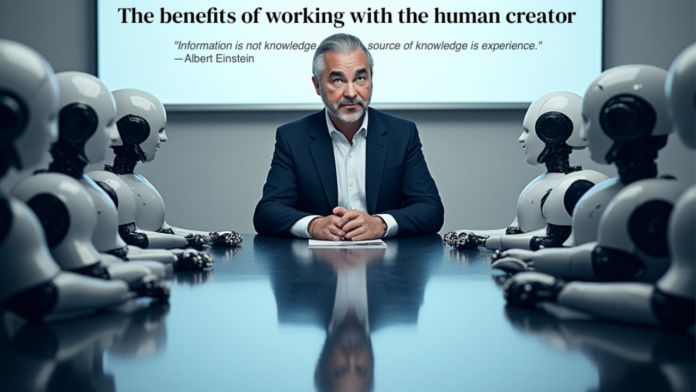In the beginning was the middleman. Then he invented the consumer. All was well until the consumer wanted something in return for the money he regularly gave the middleman. So the middleman introduced the creator. At least until the creator becomes inconvenient—an unnecessary complexity in an otherwise streamlined value chain…
The above isn’t all true, of course—but it captures the exaggerated misconception that has long shaped the imbalance in the creative industries. For too long, the lion’s share has gone not to those creating the value, but to those positioned in between. And now, in a new and challenging landscape shaped by disruptive (owners of) technologies, we see the same short-term thinking reemerge—threatening once again to undermine the foundations of a thriving future of music and culture.
As a follow-up to my recent article “The True Value of Music and the Urgent Need for Change”, which sparked valuable feedback from colleagues, I’d like to offer some further thoughts—particularly in response to questions around why developments like the “Copyrighted-as-a-Service (CaaS)” is so important and more on how it works.
It’s All About Co-Innovation and Structured Creativity
“Information is not knowledge. The only source of knowledge is experience.”
—Albert Einstein
In the age of generative AI, Einstein’s wisdom rings truer than ever. Every day, algorithms process vast amounts of information. Still, true understanding—of copyright law, creative intent, and ethical boundaries—requires systems that learn from and respect experience.
Enter Copyrighted-as-a-Service (CaaS): A framework transforming how AI collaborates with human creators while safeguarding intellectual property. This isn’t just a technical solution—it’s a philosophy for harmonizing innovation with accountability.
Why Copyright Matters in the Age of AI
Copyright law, designed for an analog world, now faces unprecedented challenges. Consider:
- 100 million+ songs exist on streaming platforms—yet AI can generate new tracks in seconds, often borrowing from protected works.
- 40% of businesses using generative AI report uncertainty about copyright compliance.
- 87% of creators worry their work will be used without attribution in AI training data.
Traditional copyright frameworks are struggling to keep up. CaaS reimagines rights management by embedding it directly into AI workflows, ensuring machines respect human creativity rather than exploit it.
How CaaS Works: The Invisible Guardian of Creativity
1. The Rights-Aware Foundation Before generating content, AI systems consult a blockchain-powered registry (CopyrightChain) to verify permissions. Think of it as a digital librarian, cross-referencing every creative element—fonts, melodies, code snippets—against ownership records. This prevents accidental infringement and flags unauthorized use for human review.
2. Context-Bound Creation Imagine an AI graphic designer tasked with creating a logo. With CaaS, the system doesn’t just follow prompts like “modern, geometric shapes.” It respects brand guidelines, regional copyright laws, and predefined stylistic boundaries—producing outputs that align with both creative vision and legal requirements.
3. Transparent Attribution After content is created, CaaS generates a full audit trail:
- Provenance tracking – which assets were used
- Royalty calculations – who earns what
- Compliance reports – how rules were followed
This transforms licensing from a bureaucratic hurdle into a real-time, automated process.
The AI Paradox: Why Following Instructions Is Harder Than It Looks
Despite their capabilities, AI systems often struggle with basic tasks:
- 48% failure rate in following multi-step instructions across leading models
- Formatting errors in 1 out of 3 AI-generated articles
These aren’t just bugs—they highlight a deeper issue. AI excels at recognizing patterns but falters with contextual obedience. For example, ask a model to “write a poem in iambic pentameter about quantum physics without mentioning light”—and you may still get verses about photons.
Teaching AI to Stay in Its Lane
New tools are emerging to address this:
- UltraIF breaks complex prompts into verifiable subtasks, improving accuracy by 62%
- AutoIF creates self-checking training data, allowing models to validate their own outputs
Rather than constrain creativity, these tools channel it—just like how a sonnet’s structure fuels poetic innovation.
The Creativity Catalyst: Why Constraints Spark Innovation
A Stanford study revealed something surprising: AI generates 34% more original ideas when given strict constraints versus open-ended prompts.
This mirrors human creativity—and provides a new way for creators to uphold their moral rights, of their works, in the digital age.
CaaS puts this into practice:
- A musician could allow AI to remix their work only in minor keys
- A novelist might permit fan fiction but block unauthorized sequels
In this way, CaaS turns legal limitations into creative launchpads—empowering creators to set the rules.
The Human-Machine Partnership: Beyond Compliance
CaaS isn’t about restricting AI. It’s about elevating human creativity.
Looking Ahead: The Future of Structured Creativity
As Einstein noted, “We cannot solve problems with the same thinking that created them.” CaaS embodies this shift—reframing copyright not as a reactive law, but as a proactive tool for the future.
Exciting developments on the horizon include:
- AI Negotiation Agents that broker licensing deals in real-time
- Style Inheritance Rights allowing artists to license their creative “DNA” to AI systems
- Decentralized Attribution Networks where every creative contribution is immutably logged
As a creator, I think you understand why I’m so deeply engaged in shaping what could become a bright future for professional human creativity.
#Copyrighted-as-a-Service #StructuredCreativity #NewInternetMedia #SustainableInnovation





















